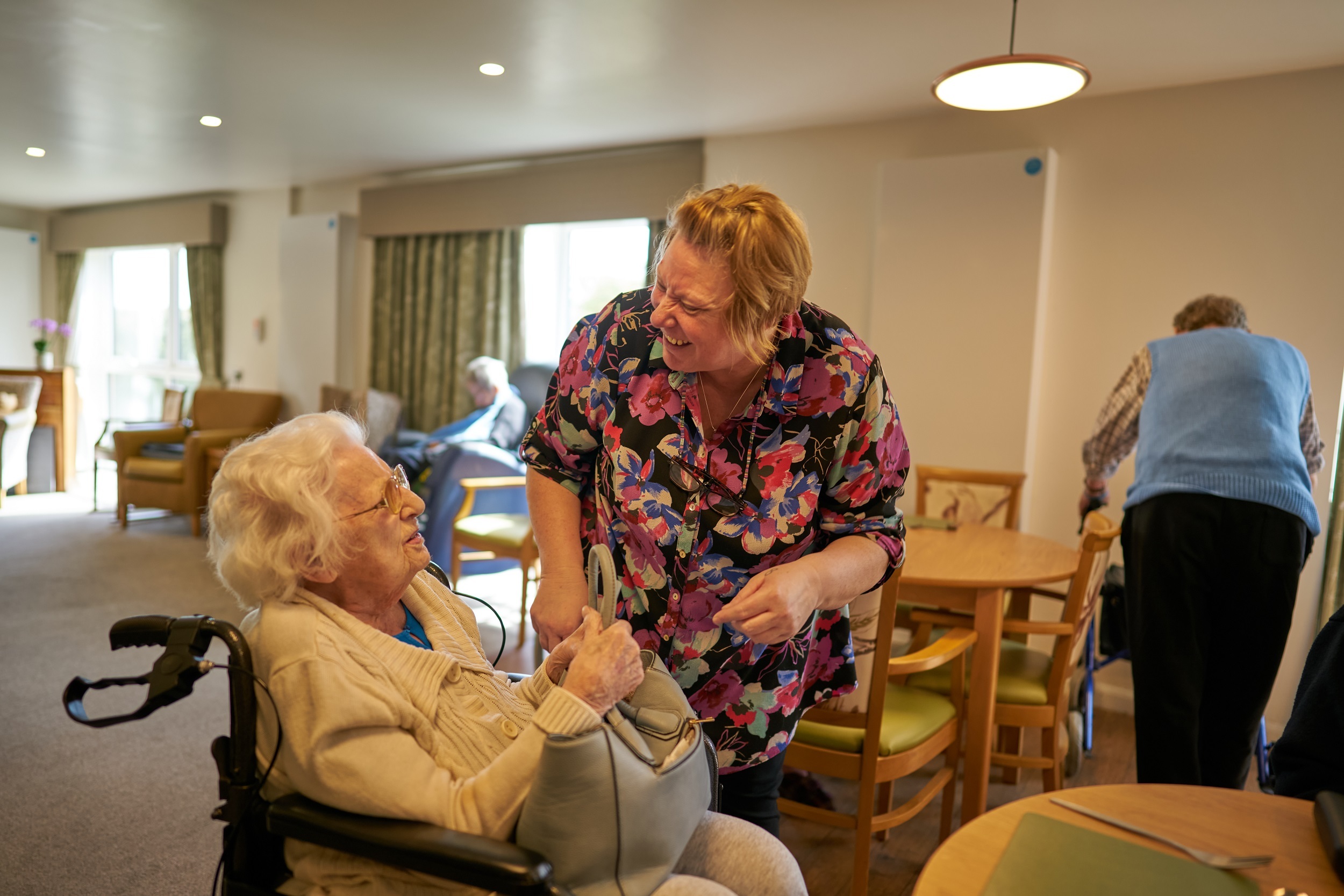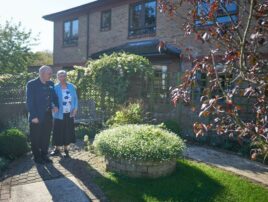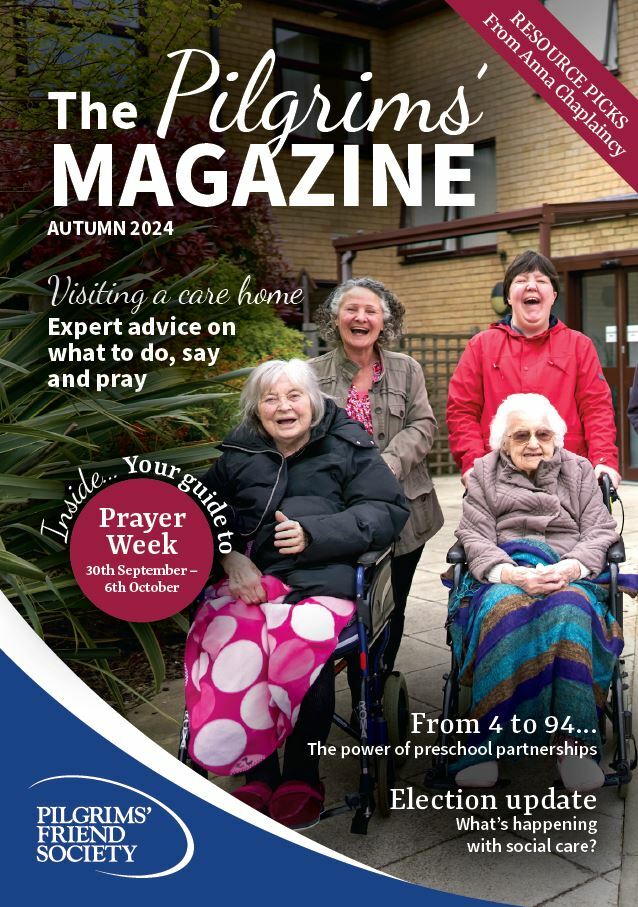
Wednesday 28th August 2024
How to approach care home visits
Former broadcaster Debbie Thrower, the original pioneer of Anna Chaplaincy for Older People (part of BRF Ministries), explores common issues that can arise in care homes and offers practical ways to navigate them…
“Don’t just do something sit there!” Yes, that is the right way round. It was a prominent sign in a hospice foyer and captures a truth about visiting. It is so tempting to arrive and start bustling about; putting flowers in a vase, or throwing out a floral arrangement that’s past its best, emptying a wastepaper bin, refreshing the water jug. Anything, but sitting and listening to what may be painful to hear.
When a relative or friend moves to a care home the dynamic changes in a relationship. For the resident it may be something of a relief to be handing responsibility for day-today living concerns to someone else. The visitor, on the other hand, views compact accommodation, home routines and staff interruptions, from their own point of view. How would I feel if this was now my home? Truthfully, less than enchanted. Perhaps downright scared?
When a care home becomes someone’s new address they would prefer a visitor who treats their new room as just that – a ‘home’. That means knocking on the door before entering – even if the door is ajar. Residents often leave their door just open a little, so they can feel connected to others and be aware of any hubbub outside while retaining some privacy.
I remember visiting my parents in residential care. It was a relief to me that the health crises we had lurched from when they were still living independently were now more manageable. However, coping with our loved one’s moods while the transition to greater dependence on others takes place is not easy.

That advice to sit with whatever he or she wants to talk about, and resist the temptation to focus instead on what you can do for them, is important.
Too often we shy away from the awkward conversations. This is where we need to learn to be more compassionate listeners. The truth is, it’s often easier to be kind, sympathetic, and patient, with someone who is not a close relative. Anna Chaplains offer spiritual and emotional support to older people in all sorts of settings including, sometimes, care homes.
They are trained listeners who seek to be person-centred and non-judgemental. What tips can we give care home visitors based on the many hours of conversations we’ve had?
Do time your visit for when someone is likely to be most alert – not just after a meal when they might prefer to be taking a nap. Quality is better than quantity. Older people in such settings may be in pain, tire easily, and a visit of 30 or 45minutes may be more welcome than one that goes on and on. If you have travelled some distance and want to make the most of it, why not withdraw for a while and return later?
Take photos or an article with you which can be the focus of a conversation about something of mutual interest. Anna Chaplains sometimes take a copy of Bible Reflections for Older People with them, which are a boon to helping broker a deeper conversation with someone who might want to talk about their faith or some of the more profound questions of life, even death. Don’t bat away any hint that your relative wants to talk about death. Even if you might hate the thought of their mortality, this is the time of life when such questions become more pressing. You’re privileged if they raise their doubts and fears with you, trusting you to react in a kind way to any worries.
Many of us, as life draws to its close, want to put our affairs in order, straighten out misunderstandings and try to ease matters on our conscience, if we can. Visitors have an important part to play in enabling someone to feel more peaceful and settled.
Sympathetic staff can sometimes be the ones who, actually, best fulfil such a role. I remember with my own mother that it was a gentle, wise, night nurse who’d listen, sometimes, to my mother in the watches of the night and who brought her much consolation over issues preoccupying her in the last stages of her life.

Often it’s our own high expectations of how a visit should go which scupper the chances of meaningful communication. We should go with few expectations but to be of help to our loved one. That might mean just sitting in companionable silence one day, or being prepared to listen attentively despite thinking you have heard this before. Don’t interrupt and move the chat on to safer ground. But go with the flow and allow whatever is on their heart to surface without steering the dialogue too much.
I remember lovely visits to both my parents which involved pushing a wheelchair around the gardens at the home, sharing some food in an impromptu picnic in the grounds, or poring over a photo album together and shedding a tear or two over our shared memories. I thought I was there to bring comfort to my parent, but they were ministering to me; teaching me how to live better.
These were precious times I wouldn’t have missed for the world. I also recall so many other residents whom I realised didn’t get regular visits. My sisters and I would make sure we tried to share a word with them as well. Perhaps that’s when the seeds were sown for Anna Chaplaincy as a way to reach people who have few if anybody left close to them, to visit and advocate on their behalf?
To receive your copy of the magazine FREE four times a year, sign up now.
There can be guilt – on both sides – when it comes to care home visits. A son or daughter, for instance, may feel they don’t go frequently enough. But even if demands on you are heavy, especially if you have children still at home, a busy job etc. making any time to go is worthwhile. In between times, a phone call or sending a card is a good substitute.
Helping a resident with an easy-to-use iPhone or iPad on which they could Facetime or exchange WhatsApp messages might transform life for them, when they sense themselves at one remove from the family action. That way a resident might feel they’re still contributing and can remain part of the landscape of their nearest and dearest.
My father defined himself, really, by being the Great Provider for the family and when that ability was taken away, as a resident, I think he felt it deeply. One way we got around that was by keeping him well supplied with chocolates. Not only did he have a sweet tooth and enjoy indulging in one every now and again himself, but he was also able to offer chocolates to others – to staff who’d been especially kind to him, and to visitors. Chocolates became his currency, which he dispensed generously! It bolstered his sense of himself as he did so.
One of the reasons we tell stories about the past, it’s said, is to check that it is still there. Everything we have ever done has made us who we are. Moving into a care facility begs a key question of us. If I don’t have much, if any, control over where I am, then who am I now?
‘The past is a foreign country: they do things differently there,’ as L.P. Hartley wrote famously in his 1953 novel The Go-Between. What we may need more than anything else from a friendly care home visit is affirmation that the affection you had for me in the past will never be withdrawn. However diminished I might be feeling, I am the same lovable person I once was, and still am.
As well as providing Anna Chaplains who work in communities, Anna Chaplaincy runs training courses and produces resources: www.annachaplaincy.org.uk
Ideas & resources to help inspire & support care home visits...

Calling all Christians: Your care home needs you!
Stories and ideas to inspire you and your church to connect with your local care home...

Worshipping With Dementia
For people with dementia, simplicity is paramount. These simple daily devotions are designed for use by caregivers, dementia sufferers, families, church groups, and medical professionals.

Caring for an Elderly Parent
A booklet sharing valuable advice on how to care for the emotional, practical and spiritual needs of a parent based on professional expertise and personal experience.



































